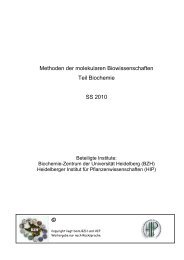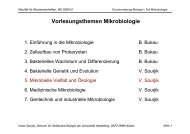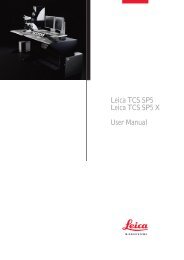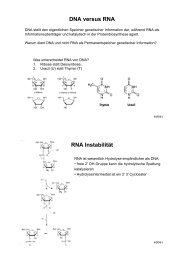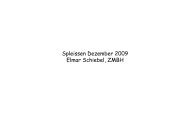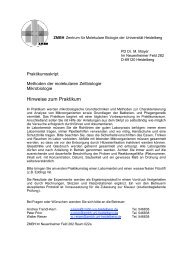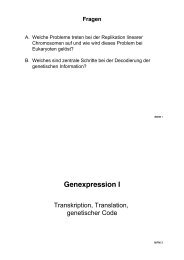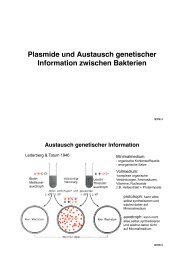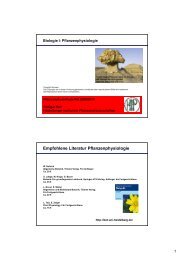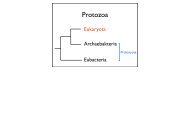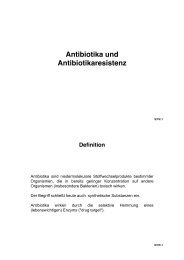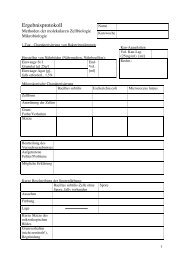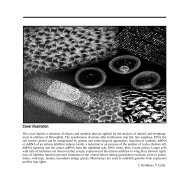ZMBH J.Bericht 2000 - Zentrum für Molekulare Biologie der ...
ZMBH J.Bericht 2000 - Zentrum für Molekulare Biologie der ...
ZMBH J.Bericht 2000 - Zentrum für Molekulare Biologie der ...
You also want an ePaper? Increase the reach of your titles
YUMPU automatically turns print PDFs into web optimized ePapers that Google loves.
Figure 4. Loss of nuclear import of DHBV core protein<br />
after mutational changes in its nuclear import signal. (A)<br />
Schematic representation of the GPF-fusion used and the<br />
mutation introduced (215RRRKVK220 → RGGEVK). (B)<br />
Cellular distribution of wild type (RRK; left panel) and<br />
mutant (GGE; right panel) in transfected HuH7 cells. GFP<br />
fluorescence in live cells was analyzed using a confocal<br />
microscope, at day 1 post transfection.<br />
the infected cell, thereby preventing abortive nuclear<br />
accumulation of capsids as observed in chronic HBV<br />
patients and in HBV transgenic mice. On the other<br />
hand, we have observed DHBc accumulation in distinct<br />
nuclear dots (particularly early in infection).<br />
These dots also accumulate pregenomic DHBV RNA,<br />
suggesting a role in RNA maturation and nuclear<br />
export.<br />
V. Envelope-independent membrane-binding<br />
preceeds budding and secretion of mature<br />
hepadnaviral nucleocapsids<br />
H. Mabit<br />
Hepadnaviruses are DNA viruses, but as pararetroviruses,<br />
their morphogenesis initiates with the encapsi-<br />
120<br />
dation of a RNA pregenome and these viruses have<br />
therefore evolved mechanisms to exclude immature<br />
nucleocapsids from participating in budding and secretion.<br />
Using the duck virus model and a flotation assay,<br />
we provide evidence that binding of cytoplasmic core<br />
particles to their target membrane is a distinct step<br />
in morphogenesis, discriminating different populations<br />
of intracellular capsids. The membrane-associated<br />
subpopulation contained largely mature, double<br />
stranded DNA genomes and was devoid of detectable<br />
core protein phosphorylation, both features characteristic<br />
for secreted virions. Against expectation, however,<br />
the selective membrane attachment observed did<br />
not require the presence of the large DHBV envelope<br />
protein, whose interaction has been implicated to be<br />
crucial for selective nucleocapsid-membrane interaction.<br />
Furthermore, removal of surface-exposed phosphate<br />
residues from non-floating capsids, did by itself<br />
not suffice to confer membrane affinity. Collectively,<br />
these observations argue for a model in which nucleocapsid<br />
maturation, involving the viral genome, the<br />
phosphorylation state, and the structure of the capsid,<br />
leads to the exposure of a membrane-binding signal as<br />
an initial step crucial for selecting nucleocapsids destined<br />
to be enveloped and secreted.<br />
VI. Recombinant hepadnaviruses as vectors<br />
for hepatocyte-directed gene transfer<br />
U. Protzer, U. Klöcker, A. Frank, in collaboration<br />
with M. Nassal, Med. Uniklinik Freiburg<br />
Being hepatropic and non-cytopathic viruses, the<br />
hepadnaviruses have been envisaged for many years<br />
to be potential candidates for the development of livertargeted<br />
viral vectors. However, due to the compact<br />
organization of the viral genome (3 kb with overlapping<br />
genes and numerous cis-acting sequence ele-<br />
ments), realization of this potential proved to be rather<br />
difficult. We have now demonstrated that, by appropriate<br />
design (i.e. replacement of the S-gene), recombinant<br />
replication-defective HBVs and DHBVs can be<br />
generated which specifically infect hepatocytes, and<br />
transduce and express foreign genes un<strong>der</strong> control of<br />
an endogenous viral promoter. Exclusive expression<br />
of the transgenes in hepatocytes, but not in non-parenchymal<br />
liver cells, confirmed the predicted tissue- and<br />
cell-type specificity.<br />
Being produced at rather high titers (ca.10 8 /ml),<br />
recombinant hepadnaviruses are useful tools for experimental<br />
gene transfer in hepatocyte cultures and for<br />
the study of hepadnaviral infection and its therapeutic<br />
treatment. For example, genetically marked DHBVs<br />
were used to demonstrate superinfection of hepatocytes<br />
with an established hepadnaviral infection. Furthermore,<br />
expression of a type I interferon, a secreted<br />
protein of therapeutic use, from such a vector interfered<br />
with the replication of the resident virus (Fig.5).<br />
These data introduce the use of local cytokine produc-<br />
Figure 5. Therapeutic effect of a recombinant DHBV transducing<br />
an interferon gene. Preinfected duck hepatocytes<br />
were superinfected at various ratios (moi) with rDHBV-<br />
IFN or with rDHBV-GFP as a negative control. The time<br />
course of progeny virus release is shown.<br />
tion by HBV-mediated gene transfer as a new concept<br />
for the treatment of acquired liver diseases, including<br />
chronic hepatitis B. Finally, by developing genetically<br />
marked hepadnaviruses, provide a simple assay to the<br />
identification of infectable cells, and the opportunity<br />
for gene transfer approaches in searching for the missing<br />
DHBV-coreceptor or other missing co-factors.<br />
VII. A spring-loaded topology of the large<br />
envelope protein of Duck hepatitis B<br />
virus<br />
In collaboration with E. Grgacic, Melbourne<br />
The structure and fusion potential of the duck hepatitis<br />
B virus (DHBV) envelope proteins was examined<br />
by treating viral particles with deforming agents<br />
known to release envelope proteins of viruses from<br />
a metastable to a fusion-active state. Exposure of<br />
DHBV particles to low pH triggered a major structural<br />
change in the large envelope protein (L) resulting in<br />
exposure of a new trypsin cleavage site within its<br />
S domain, but without affecting the same region in<br />
the small surface protein (S) subunits. This conformational<br />
change was associated with increased hydrophobicity<br />
of the particle surface most likely arising<br />
from surface exposure of the hydrophobic first transmembrane<br />
domain. In the hydrophobic conformation,<br />
DHBV particles were able to bind to liposomes and<br />
intact cells, while in their absence these particles<br />
aggregated, resulting in viral inactivation. These results<br />
suggest that some L molecules are in a spring-loaded<br />
metastable state which, when released, expose a previously<br />
hidden hydrophobic domain, a transition potentially<br />
representing the fusion active state of the envelope.<br />
121



